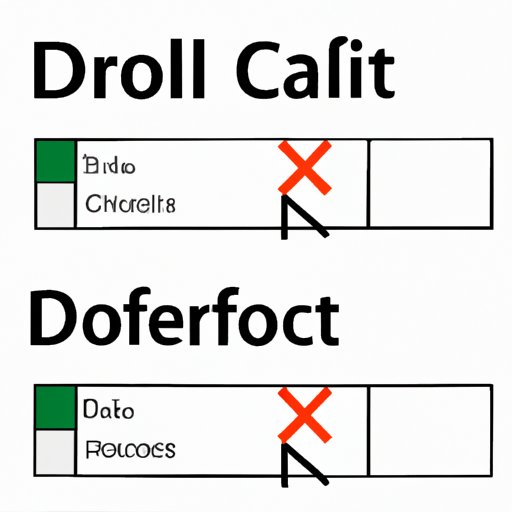I. Introduction
If you’re looking to create a user-friendly and organized spreadsheet, drop-down lists are an essential tool. By allowing users to select from pre-created options, you can ensure data accuracy and streamline the input process.
This article is intended for anyone interested in learning how to create drop-down lists in Excel. We’ll start with the basics of creating a simple drop-down list, and then move on to more advanced techniques that allow for greater customization and functionality.
II. Step-by-Step Tutorial
Creating a drop-down list in Excel can be done in just a few simple steps. Here’s a quick overview:
1. Select the cell or cells where you want to create the drop-down list.
2. Go to the “Data” tab and click on “Data Validation”.
3. In the “Settings” tab, select “List” in the “Allow” field.
4. In the “Source” field, enter the range of cells containing the options you want to appear in the drop-down list.
5. Click “OK” to apply the changes.
For a more detailed walkthrough of each step, including screenshots, check out our full tutorial on creating a drop-down list in Excel. Additionally, we’ll provide some troubleshooting tips for common issues you may encounter along the way.
III. Common Errors to Avoid
Even with these simple steps, creating a drop-down list in Excel can be frustrating if you encounter common errors. Some of the most popular are:
– Not using a named range for the source list
– Using blank cells in the source range
– Failing to copy and paste the drop-down list properly
– Having leading or trailing spaces in the cells
To avoid these errors, make sure you name the range of cells containing the options you want to appear in the drop-down menu and double-check for any blank cells or trailing spaces. If you encounter issues with copying and pasting, use the “Paste Special” function and select “Validation” to ensure the formatting is correct.
IV. Using Data Validation
Data validation is an essential tool for creating accurate and user-friendly drop-down lists in Excel. In simple terms, data validation allows you to specify what kind of data is allowed in a cell, as well as any particular constraints or requirements.
When creating a drop-down list, data validation ensures that users can only select from pre-defined options, reducing the risk of input errors. To create a drop-down list using data validation, follow these steps:
1. Select the cell or cells where you want to create the drop-down list.
2. Go to the “Data” tab and click on “Data Validation” in the “Data Tools” group.
3. In the “Settings” tab, select “List” in the “Allow” field.
4. In the “Source” field, enter the range of cells containing the options you want to appear in the drop-down list.
5. Click “OK” to apply the changes.
Data validation is a powerful tool that can be used for much more than just creating drop-down lists. By setting constraints on inputs such as dates, numbers or text, you can ensure your data remains accurate and consistent.
V. Best Practices for Design
When creating drop-down lists in Excel, it’s important to consider not only the content but the design itself. A well-designed drop-down list can increase usability, readability, and organization. Here are some of the best practices for designing drop-down lists:
1. Keep the list consistent with the overall aesthetic of your spreadsheet.
2. Consider color-coding to quickly convey information.
3. Use a clear and readable font.
4. Place the list close to the relevant data or input fields for easy navigation.
5. Make the list long enough to display all options without needing to scroll.
These design tips will ensure that your drop-down lists are easily readable, user friendly, and quickly navigable within your spreadsheet.
VI. Advanced Techniques
While creating a basic drop-down list in Excel is relatively simple, there are a number of more advanced techniques that can be used to create even more sophisticated drop-down options. These include:
– Linked lists, which allow you to create drop-down lists that change based on the selection in another cell.
– Formulas, which can be used to customize the options displayed in the drop-down list based on data in the spreadsheet.
– Macro codes, which can be used to automate the entry process with a click of a button.
For a detailed walkthrough of these techniques, as well as tips for customizing your drop-down list’s appearance and functionality, check out our tutorial on advanced techniques for creating drop-down lists in Excel.
VII. Tips for Optimum Efficiency
Drop-down lists can be a major timesaver, but there are also ways to streamline the process of creating them. Some tips for optimizing the efficiency of your drop-down lists include:
– Use named ranges to make it easier to update the options on the list later.
– Copy and paste the drop-down list to other cells to save time and maintain consistency.
– Save the drop-down list as a reusable template for future use.
– Hide the source data or other unnecessary columns or rows to avoid distraction.
By following these tips, you can ensure that your drop-down lists are both user-friendly and efficient for inputting data into your spreadsheet.
VIII. Conclusion
Creating drop-down lists in Excel is a powerful tool for reducing data errors, enhancing the user experience, and increasing overall efficiency. By following these steps, you’ll be able to create accurate and sophisticated drop-down options, while avoiding common errors and optimizing the design process.
While the process of creating a basic drop-down list is relatively simple, the advanced techniques and best practices outlined here will allow you to take your lists to the next level. By using data validation, thoughtful design, and advanced techniques such as linked lists and macros, you can create user-friendly and efficient drop-down lists that add real value to your spreadsheet.
